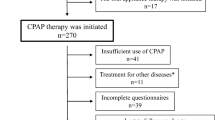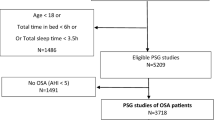Abstract
Obstructive sleep apnea (OSA) is a common disease with significant medical and psychiatric comorbidities. The literature documenting the effects of continuous positive airway pressure (CPAP) treatment on mood in OSA patients is mixed. We previously observed that 1 week of CPAP treatment did not result in improvements in mood beyond those observed in a group treated with placebo–CPAP. This study examined the effect of a 2 week CPAP treatment on mood in a placebo-controlled design in OSA patients. Fifty patients with untreated sleep apnea were evaluated by polysomnography and completed the Profile of Mood States (POMS) pre-/post-treatment. The patients were randomized for 2 weeks to either therapeutic CPAP or placebo–CPAP (at insufficient pressure). Both the therapeutic CPAP and the placebo–CPAP groups showed significant improvements in POMS total score, tension, fatigue, and confusion. No significant time × treatment effect was observed for either group. We could not show a specific beneficial impact of CPAP treatment on mood in OSA patients.

Similar content being viewed by others
References
Cheshire K, Engleman H, Deary I et al (1992) Factors impairing daytime performance in patients with sleep apnea/hypopnea syndrome. Arch Intern Med 152:538–541
Newman AB, Nieto FJ, Guidry U et al (2001) Relation of sleep-disordered breathing to cardiovascular disease risk factors: the Sleep Heart Health Study. Am J Epidemiol 154:50–59
Engleman HM, Cheshire KE, Deary IJ et al (1993) Daytime sleepiness, cognitive performance and mood after continuous positive airway pressure for the sleep apnoea/hypopnoea syndrome. Thorax 48:911–914
Douglas NJ (1998) Systematic review of the efficacy of nasal CPAP. Thorax 53:414–415
Derderian SS, Bridenbaugh RH, Rajagopal KR (1998) Neuropsychologic symptoms in obstructive sleep apnea improve after treatment with nasal continuous positive airway pressure. Chest 94:1023–1027
Engleman HM, Martin SE, Deary IJ et al (1994) Effect of continuous positive airway pressure treatment on daytime function in sleep apnoea/hypopnoea syndrome. Lancet 343:572–575
Engleman HM, Martin SE, Deary IJ et al (1997) Effect of CPAP therapy on daytime function in patients with mild sleep apnoea/hypopnoea syndrome. Thorax 52:114–119
Means MK, Lichstein KL, Edinger JD et al (2003) Changes in depressive symptoms after continuous positive airway pressure treatment for obstructive sleep apnea. Sleep Breath 7:31–42
Schwartz DJ, Kohler WC, Karatinos G (2005) Symptoms of depression in individuals with obstructive sleep apnea may be amenable to treatment with continuous positive airway pressure. Chest 128:1304–1309
Yu BH, Ancoli-Israel S, Dimsdale JE (1999) Effect of CPAP treatment on mood states in patients with sleep apnea. J Psychiatr Res 33:427–432
Borak J, Cieslicki JK, Koziej M et al (1996) Effects of CPAP treatment on psychological status in patients with severe obstructive sleep apnoea. J Sleep Res 5:123–127
Munoz A, Mayoralas LR, Barbe F, Pericas J, Agusti AG (2000) Long-term effects of CPAP on daytime functioning in patients with sleep apnoea syndrome. Eur Respir J 15:676–681
Gay P, Weaver T, Loube D, Iber C, Positive Airway Pressure Task Force, Standards of Practice Committee, American Academy of Sleep Medicine (2006) Evaluation of positive airway pressure treatment for sleep related breathing disorders in adults. Sleep 29:381–401
Anonymous (1983) 1983 Metropolitan height and weight tables. Stat Bull Metrop Life Found 64:3–9
Rechtshaffen A, Kales A (1968) A manual of standardized terminology: techniques and scoring system for sleep stages of human subjects. UCLA Brain Information Service/Brain Research Institute, Los Angeles
Gould GA, Whyte KF, Rhind GB et al (1998) The sleep hypopnea syndrome. Am Rev Respir Dis 137:895–898
McNair DM, Lorr M, Droppleman LF (1992) POMS manual: profile of mood states. Educational and Industrial Testing Service, San Diego, CA
Cella DF, Tross S, Orav EJ et al (1989) Mood states of patients after the diagnosis of cancer. J Psychosoc Oncol 7:45–54
DiLorenzo TA, Bovberg DH, Montgomery GH et al (1999) The application of a shortened version of the profile of mood states in a sample of breast cancer chemotherapy patients. Br J Health Psychol 4:315–325
Holland JC, Korzun AH, Tross S et al (1986) Comparative psychological disturbance in patients with pancreatic and gastric cancer. Am J Psychiatry 143:982–986
Shumaker SA, Anderson RT, Czajkowski SM (1990) Psychological tests and scales. In: Spilker B (ed) Quality of life assessments in clinical trials. Raven, New York, pp 95–114
Spiegel D, Bloom JR, Yalom I (1981) Group support for patients with metastatic cancer: a randomized prospective outcome study. Arch Gen Psychiatry 38:527–533
Taylor SE, Lichtmain RR, Wood JV (1984) Attributions, beliefs about control and adjustment to breast cancer. J Pers Soc Psychol 46:486–501
Taylor SE, Lichtmain RR, Wood J et al (1985) Illness and treatment-related factors in psychological adjustment to breast cancer. Cancer 55:2503–2513
Dickel MJ, Mosko SS (1990) Morbidity cut-offs for sleep apnea and periodic leg movements in predicting subjective complaints in seniors. Sleep 13:155–166
Mosko S, Zetin M, Glen S et al (1989) Self-reported depressive symptomatology, mood ratings, and treatment outcome in sleep disorders patients. J Clin Psychol 45:51–60
Bardwell WA, Moore P, Ancoli-Israel S et al (2003) Fatigue in obstructive sleep apnea: driven by depressive symptoms instead of apnea severity? Am J Psychiatry 160:350–355
Salinsky MC, Storzbach D, Dodrill CB et al (2001) Test–retest bias, reliability, and regression equations for neuropsychological measures repeated over a 12–16-week period. J Int Neuropsycho Soc 7:597–605
Castrén E (2005) Is mood chemistry Nat Rev Neurosci 6:241-6
Acknowledgments
This research was supported by NIH grants AG08415, HL44915, HL36005, and RR00827.
Author information
Authors and Affiliations
Corresponding author
Rights and permissions
About this article
Cite this article
Haensel, A., Norman, D., Natarajan, L. et al. Effect of a 2 week CPAP treatment on mood states in patients with obstructive sleep apnea: a double-blind trial. Sleep Breath 11, 239–244 (2007). https://doi.org/10.1007/s11325-007-0115-0
Published:
Issue Date:
DOI: https://doi.org/10.1007/s11325-007-0115-0




